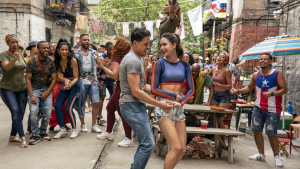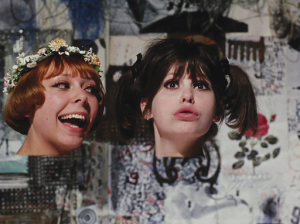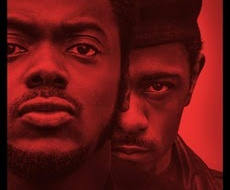Why do I love the ‘Fear Street Trilogy’ (2021) so much?
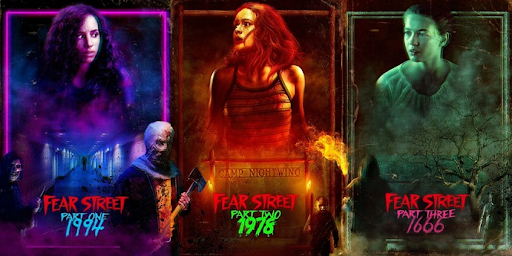
Kiana Madeira, Olivia Scott Welch on the posters of the three “Fear Street” movies.
August 20, 2021
At the beginning of “Fear Street: 1994” (2021), there’s a very important misdirect which rings as a sort of thematic anchor for the trilogy. A woman buys a pulpy horror novella from a store that is managed by a teenager played by Maya Hawke (who seems to now be typecast as a sardonic Netflix teen who works at a mall). While Hawke’s character finds the woman’s taste in fiction admirable, the woman clarifies that SHE wouldn’t be caught dead reading low brow trash like that and that it’s for her stepdaughter. In the moment, this reads as a condemnation of the people who can’t loosen up and enjoy schlocky horror flicks, and that the audience shouldn’t take things so seriously and enjoy the ride. But upon further examination, there is actually a surprising amount of depth to this brief exchange. The woman doesn’t just deny the value of pulp as entertaining spectacle, but devalues it as a way of telling real stories. This, it seems, is the real goal of the “Fear Street” trilogy: to not only give a love letter to the various tropes of different types of horror, but to use that medium to tell stories which wouldn’t normally be palatable to the people who consume them.
“Fear Street: 1994”, “Fear Street: 1978” (2021), and “Fear Street: 1666” (2021) make up an incredibly ambitious trilogy of serialized horror films directed by Leigh Janiak in partnership with Netflix. Each film was released one week after each other, and they tell a sprawling tale of two dueling towns, undying lesbian romance, and serial killers who come back from the grave to hunt down some teenagers. While each film has a major portion of its runtime devoted to characters from a different time period, the main storyline takes place in 1994 and centers Deena Johnson, an intensely snarky and emotionally volatile teenage girl who’s just broken up with her girlfriend, Sam Fraser. This breakup is the emotional catalyst for the trilogy and sets up the central conflict (apart from the serial killers). Two towns, unalike in dignity, in fair Ohio, where we lay our scene. There’s Sunnyvale – where Sam has just moved thus causing her schism with Deena – a model American town full of wealth and prosperity, and then there’s Shadyside – where Deena and her friends live – which is the murder capitol of the US. After the underlying conflict of the franchise is set into motion by Deena and Sam’s breakup, a car crash partially caused by the former gives way to the more pressing conflict: former Shadyside serial killers are coming back from the grave to try and kill Sam.
Now all of this might seem rather juvenile at first glance. Each of these elements has been done a million times before by many different slasher movies, but that’s precisely the point. This is first and foremost a love letter to pulpy horror movies, ranging from American classics to the Hammer Films of Britain to the gialos of Italy. And as love letters go, this one is pretty good! While the beginning is clumsy in a way which I don’t think is intentional, the pace is fast enough that the first film gets good before too long, and it gets very good. When the first film gets moving, it almost works well enough to succeed not just as a schlocky horror flick, but as a good movie. I also would be remiss to not mention the presentation of the trilogy, which is incredibly strong. Each time period has a very specific color palette which is both distinctive and appealing, a surprisingly difficult feat in modern mainstream cinema. The segments in 1994 are most clearly influenced visually by the films of Dario Argento, mainly “Suspiria” (1977), with bold colored lighting which re-enforces the nightmarish tone. While the influence of the other two time periods’ visual styles aren’t as clear, they still are consistently good looking, with deep blacks and vibrant colors which make everything pop.
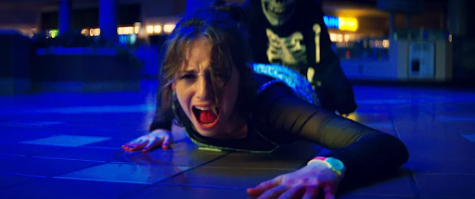
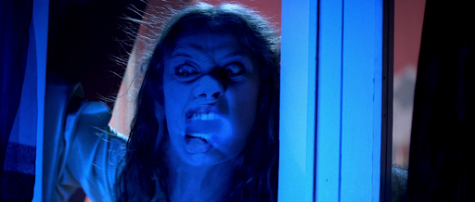
That’s the kind of thing that makes the “Fear Street Trilogy” so exciting to me. It is by no means high art – far from it – but what it lacks in refinement, it makes up for in a story about issues which a good portion of Americans refuse to consider in a way which is both accessible and emotionally satisfying. Well, accessible to people who like excessive violence and cursing. If any of this seems appealing to you, or even if you think I’m an overly political snowflake and just want to watch an exceedingly entertaining horror trilogy, I highly recommend you give this trilogy a watch. You can catch it on Netflix.

